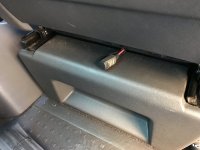Just posting from the other topic to keep it all together:
Other topic:
https://vwcaliforniaclub.com/threads/extension-lead-for-a-waexo-cfx-fridge.18173/#post-208004
Not sure but if the mods could possibly combine this and the linked topic that would be great as the conversation is going on in two places with relevant bits in both topics

) but multiple connections and thin cable = voltage drop = fridge cut out especially with engine off running. Most of the 12v cig lighter adaptors/extensions etc are cr@p quality and you need higher amperage rated cable to avoid this even if they live up to what they are rated at...
Check here for lots more on running 12v portable fridges.
https://www.google.co.uk/search?rlz...p..0.15.1632.3..41j0i131k1j0i67k1.NYyPiopt7Bw
Why it fails to provide the voltage expected:
http://www.fridge-and-solar.net/socket.htm
So, in the Cali Beach the cabling goes from the leisure battery under the nearside seat to the bulkhead area (and in the Ocean/SE of course one of these batteries is at the back of the vehicle), then presumably through some wizardry and components and then has to go through maybe another 15 ft of cable back to the rear most cigarette lighter socket. This cable will be just OK quality as will be the socket as VW use a lot of it and want to save money.
You then plug in an amp-hungry fridge using a funny little plug originally designed to power a heated element for a few seconds in the 1960's but that somehow the whole industry continues to use. Look at the end of the plug and the front surface of that little tip is all the area the current has to flow through.
If you get a multimeter and measure the voltage at each of the sockets you may find 12.5v but add a load and measure again so see what is now coming through. As in the link above this is OK with the engine running as the alternator will supply 14.5v and this compensates for the loss but with engine off and a load you may only see 10.5 volts.
Or add an extension to an existing socket (and another terrible interface for the current to struggle through) and wave bye bye to another volt or so...

Check the links above - most of the discussions will be from 4x4 expedition types and marine forums as these people want a proper reliable supply - in comparison the stuff in the motorcaravan world and Amazon/eBay is cheap Chinese manufacture.
Lower wattage appliances like chargers and lights will be fine but a fridge demands more.
Hard wiring with high rated cable and high quality connectors and an inline fuse is the way to go. You can still disconnect easily under the seat and have a long cable and move it all around but the voltage will be reliable and the fridge will be more efficient and work great.




















